Travelling business class within Europe is unlike almost anywhere else in the world, given the Eurobusiness seat style — economy but with no middle seat in the row of three seats — universal whether you’re flying with an Air France-KLM, IAG, Lufthansa Group or unaligned carrier.
Fifteen years ago, Lufthansa redefined the Eurobusiness hard product for a generation with its NEK (Neue Europakabine) product, installing the Recaro BL3520 seat in a densification and product simplification exercise that spelled the end for the convertible economy seat (where the centre armrests and, in the case of British Airways, a set of seats on one entire side of the aircraft, moved to make way for wider seat pans in the four remaining seats on each row).
![Interior, Lufthansa A320 family aircraft. Looking backwards from the last row of Eurobusiness, with the curtain separating it from the rest of economy, which are the same grey seats but without the central "Ihr Freiraum [Lufthansa logo] Your Space" mid brown-accented headrest cover.](https://theupfront.media/content/images/2025/05/IMG_7270-aeee32d58ea565f1.jpg)
Those NEK seats are still flying today on Lufthansa and its sister airlines, even with the 2019 change from Recaro to Geven Essenza seats. Indeed, on this trip from Lyon to Hamburg and back via Frankfurt, three of the four flights featured NEK rather than Essenza.
Lufthansa sets passengers’ expectations for these flights — which it refers to as “short and medium-haul business class” — with marketing including:
- “relaxation right from the start”
- “privacy and plenty of room for working or relaxing”
- “personal space on board to work undisturbed or to rest in a comfortable environment”
- “even on short and medium-haul routes, in Lufthansa Business Class you can expect a full meal which will be served on high-quality china”
The reputation Lufthansa’s Eurobusiness has is for a very consistent experience that sets the standard among its competitors — indeed, overall it’s much better in Eurobusiness than it is in longhaul business, where it’s much more at the bottom of the pack.
With four flights in quick succession — to the Aircraft Interiors Expo in Hamburg, and thus with passenger experience at front of mind — it was informative to sit down and consider how the experience stacked up.
Flight choice, selection and booking: average, despite the greenwashing
The reality of my primary airport being a non-hub city like Lyon is that, unless I’m going to an airline hub like London or Brussels, or to a holiday destination on a low-cost airline, I have to transfer at one of those hubs. That’s certainly the case for this trip — and this is one of the journeys where I always consider my options carefully for several key reasons.
Pricing-wise, fares are usually keenest on the Lufthansa Group airlines: Air France-KLM seemingly doesn’t feel the need to compete on price for the French market via CDG or AMS (and many flights are on regional aircraft with sub-par seat layouts in Eurobusiness), while London is the only reasonable connecting point for IAG and pricing is never keen for this connection.
So Lufthansa Group it is, and I usually end up paying for business class rather than economy: I pack two suitcases of work clothes and equipment for the week in Hamburg, which usually means the pricing from regular luggage-included economy fare plus one bag equals the price of business class.
(There is, however, a heavy push for its nonsense greenwashing “Green Fares”, which are so risible a cash grab in the name of environmentalism that they bring the airline and indeed the industry into disrepute.)
Other factors putting a finger on the scale for business include the second piece of hand luggage included (necessary since, of the three times my checked bags have gone astray in my life, it has always been on Lufthansa via Frankfurt, so I pack two full days’ clothes in my carryon, plus all my work equipment), and the ability to not be shoulder-to-shoulder with someone after a week of overstimulation. Also important for this annual trip: lounge access in case of misconnection, which happens more often than I’d like thanks to Frankfurt being awful and Lufthansa not taking account of operational reality in its minimum connection times.
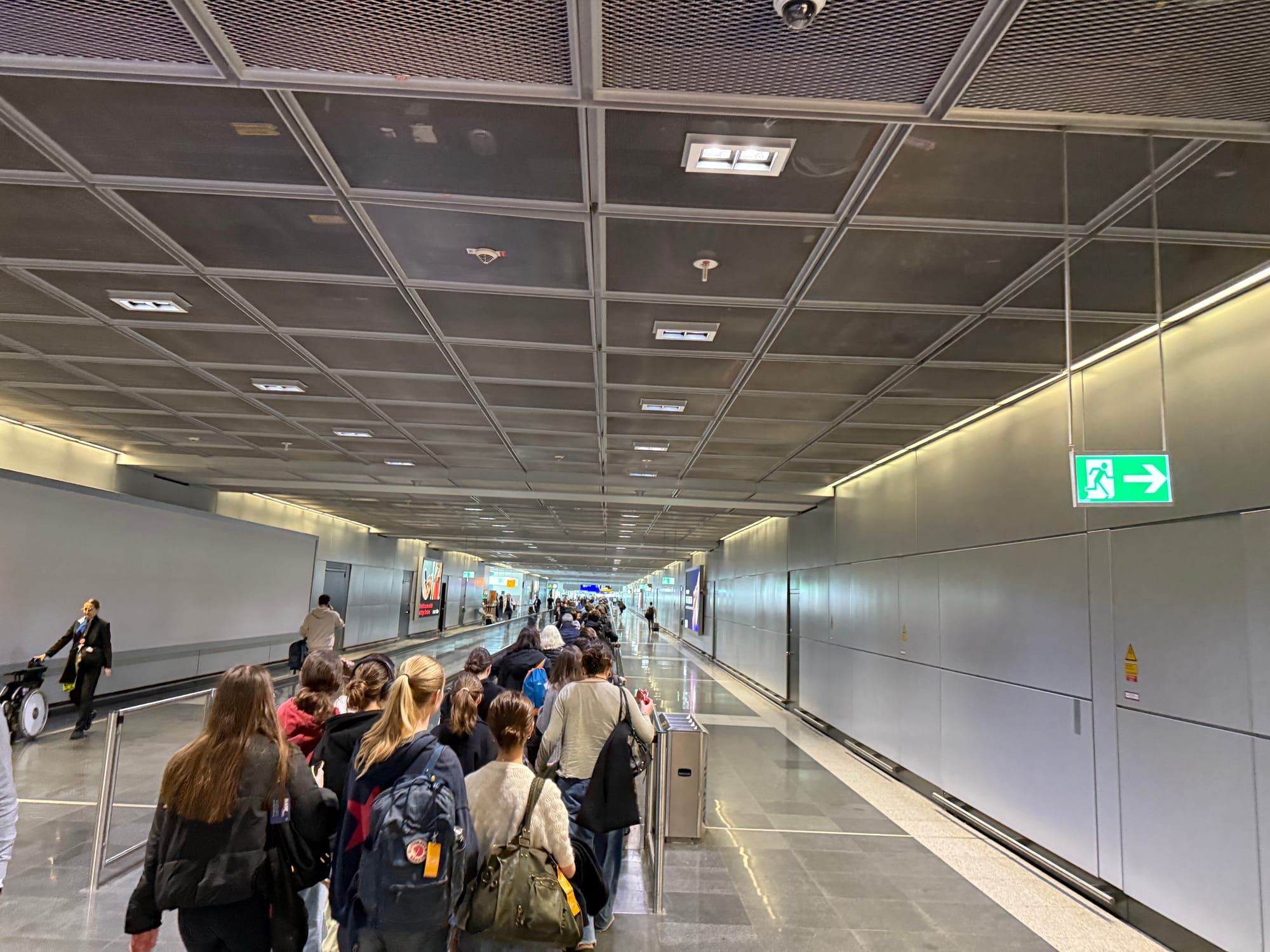
Ten years ago, I would have chosen Munich in a heartbeat over Frankfurt, and between other cities I still would. Now, though, Munich-Lyon flights are often wetleased out to either airBaltic or Air Dolomiti — a passenger experience upgrade in both cases for sure, but they end up in one of Munich’s multiple bus gate pigpens, which is not great for connections or having to hump luggage up and down several flights of stairs in the terminal, then up and down the airplane stairs too. All this means that the once-superior MUC is only slightly better than FRA in the Lufthansa experience these days.
If timings work, I prefer Brussels Airlines or Austrian, whose small terminals at BRU and VIE are much more convenient than either FRA or MUC these days, but that wasn’t the case this time, and the Munich flight times weren’t ideal, so reluctantly (since Frankfurt is the worst airport hub in Europe) I booked via FRA both ways.
Site, app, technology and personalisation: above average on adoption, but integration challenges remain
Being an elderly Millennial whose personal philosophy remains that flights are a big purchase, the sort done on the big screen of a computer rather than the little screen of a phone, I booked via Lufthansa’s website. This is much less clunky than it used to be, and viewing flights, connecting airports, connection times, aircraft and so on — as well as selecting seats — was easy enough.
Lufthansa also pushes its Travel ID personalisation option, which as a partner frequent flyer (for the few miles one collects in Eurobusiness) I’d never used before and which always seemed like a bit of a data grab. Indeed, LH has never really managed in all the flying I’ve done with them to explain what use a Travel ID really is, what the benefits are, and how it differs from just signing into their website with PNR and last name, and that remained the case this time. Out of interest, I tried out the experience without a Travel ID on the outbound and with it on the return. There was absolutely no perceptible benefit to Travel ID in any way.
![Screenshot of an iPhone lock screen with two notifications. The first is a Live Activities notification showing: On Time flight, LH1077 1/2, Arrival at 15:58, Arrival terminal 1, gate area A, LYS 14:45 [plane icon] 15:58 FRA. The second is a boarding pass notification with the Lufthansa logo in white on a yellow background, the word "Lufthansa", "Today at 14:05", and a thumbnail of a boarding pass.](https://theupfront.media/content/images/2025/05/IMG_7304-cdb9a47a54141605.PNG)
Lufthansa’s app, though, is pretty good. It integrates well with iOS’s Live Activities function to show up-to-the-minute information about your flight, while inside the app there are useful functions like gate mapping and even gate directions — super-helpful in Frankfurt, for sure.
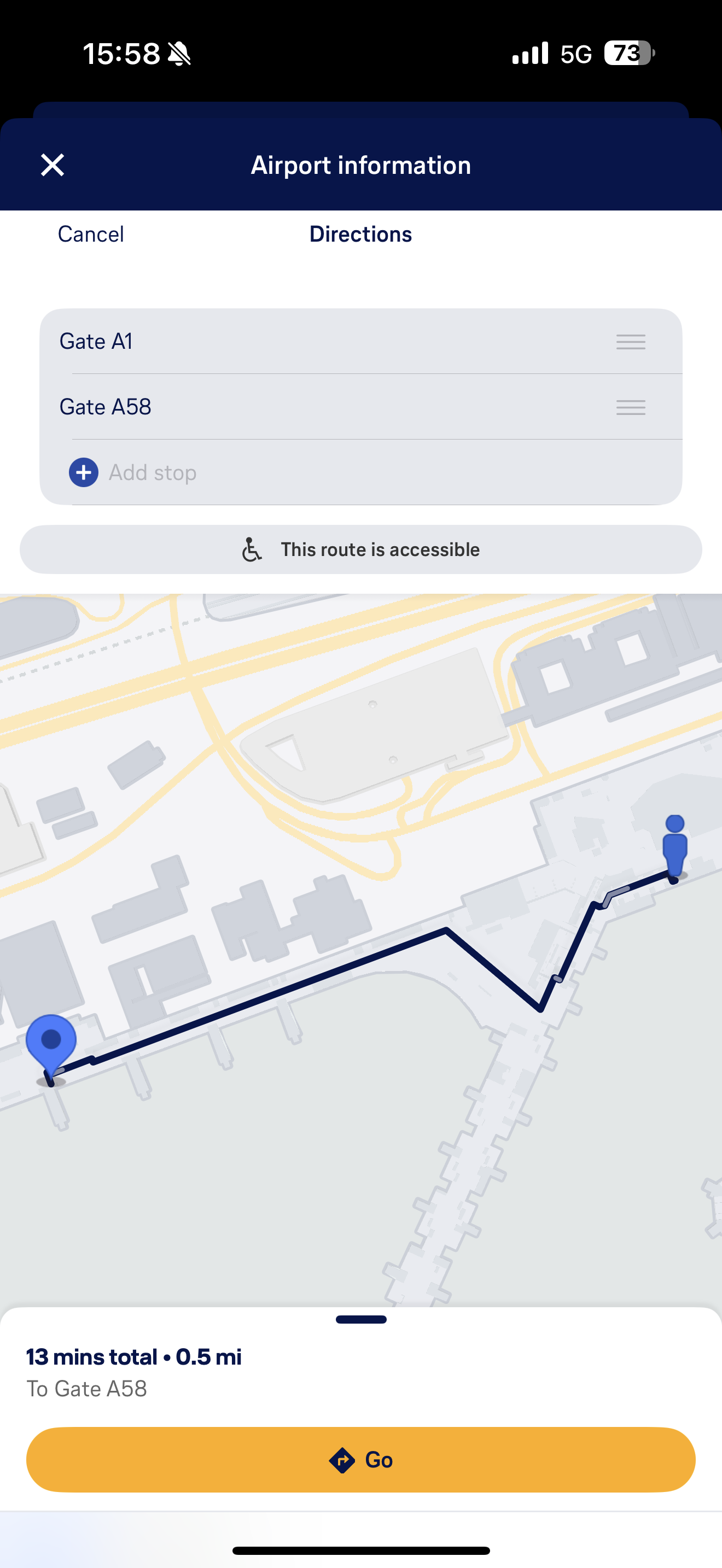
There are some stumbling blocks here around data presentation, though: we ended up at one of the FRA bus gates, but the app showed gate ASO, which I happen to know through this being my literal job means “A Schengen Ost [East in German]”, in other words a Schengen bus gate at the east position on the A terminal, but this could more usefully be displayed as “Bus Gate A East” or something.

Similarly, it feels like there’s room for much around both Live Activities and the persistent Wallet boarding pass notification. Do both of these need to be present for the entire journey? Is there a reason I need to import both boarding passes into my Wallet separately?
In terms of in-journey notifications for events like baggage acceptance (with tracking reference number), gate allocation, gate changes and so on, Lufthansa seems to err on the side of more information rather than less, sending emails for several events. I found this useful — I’d always rather have an email lurking in my inbox with my baggage tracking number in case my luggage goes astray, and so on — but I can see others might find this annoying, and there seemed to be little option to adjust the frequency or delivery method.
Airports, lounges, boarding and preflight: truly terrible at almost every turn
The airport experience is where the Lufthansa experience is really let down. Let’s start at Lyon, the first airport on the trip.
In Lyon, Lufthansa’s counters are in the newer Terminal 1, and I know where they are, so headed straight there. I did observe that the white writing on yellow background for Lufthansa was much less legible than other branding, however. Checkin and bag drop went smoothly, and Lyon’s fast lane for security — as well as its laptops-in, liquids-in bag scanners — worked well.
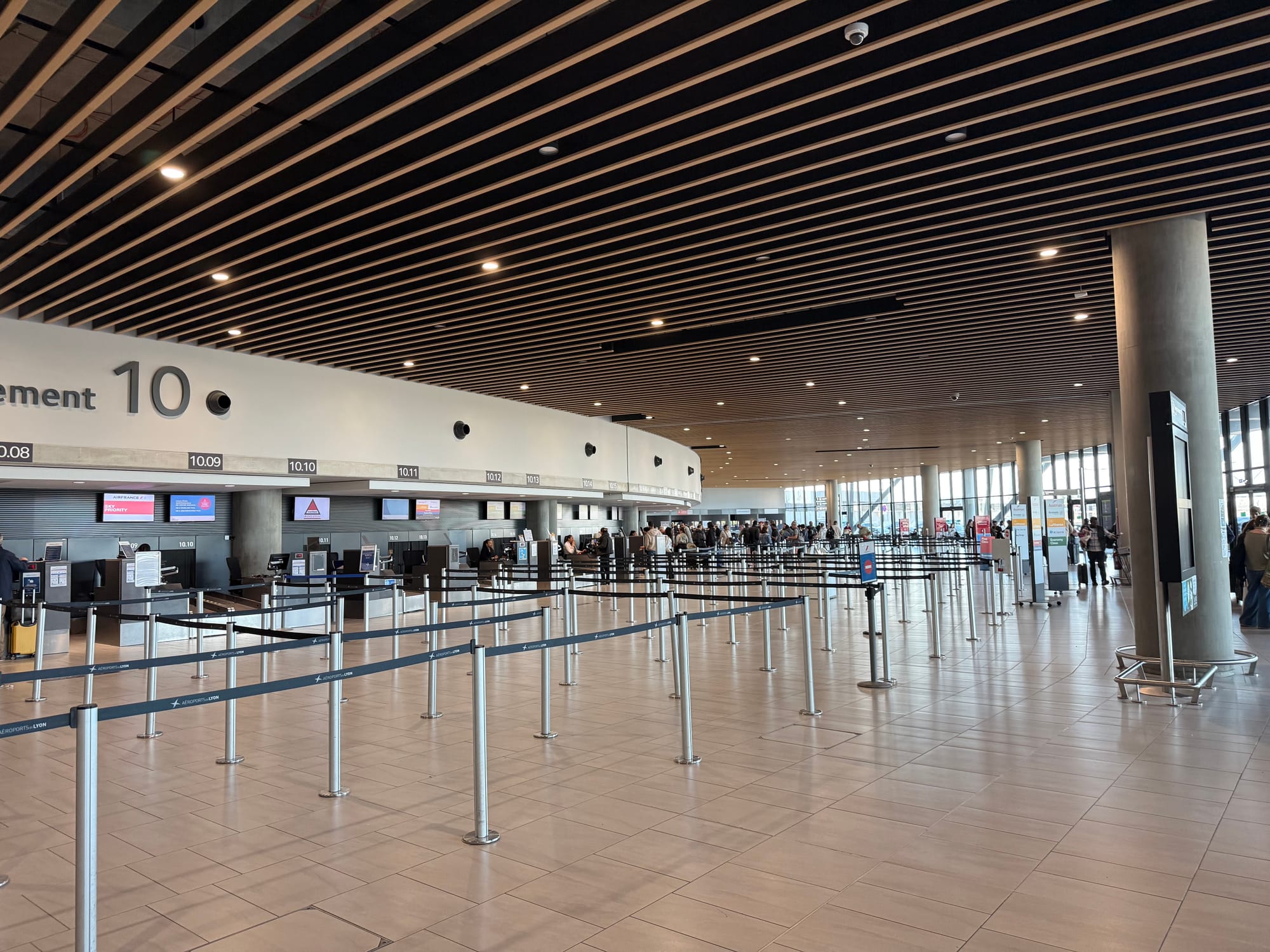
There’s only one airport lounge for Schengen flights in Lyon, the dreadful Confluence in a windowless box, and as usual it was unclean, untidy and unpleasant. Despite Lyon’s reputation as a foodie destination, the food here is truly terrible, and I’ll usually stop at the airport Starbucks for a snack rather than the selections here, which included an enormous tray of breaded fish balls and a sloppy bucket of something marked as “Indian vegetal pan-fried” but which more closely resembled brown vegetable soup, with a thick line of oil on the top. Still, Lufthansa has no other option here.
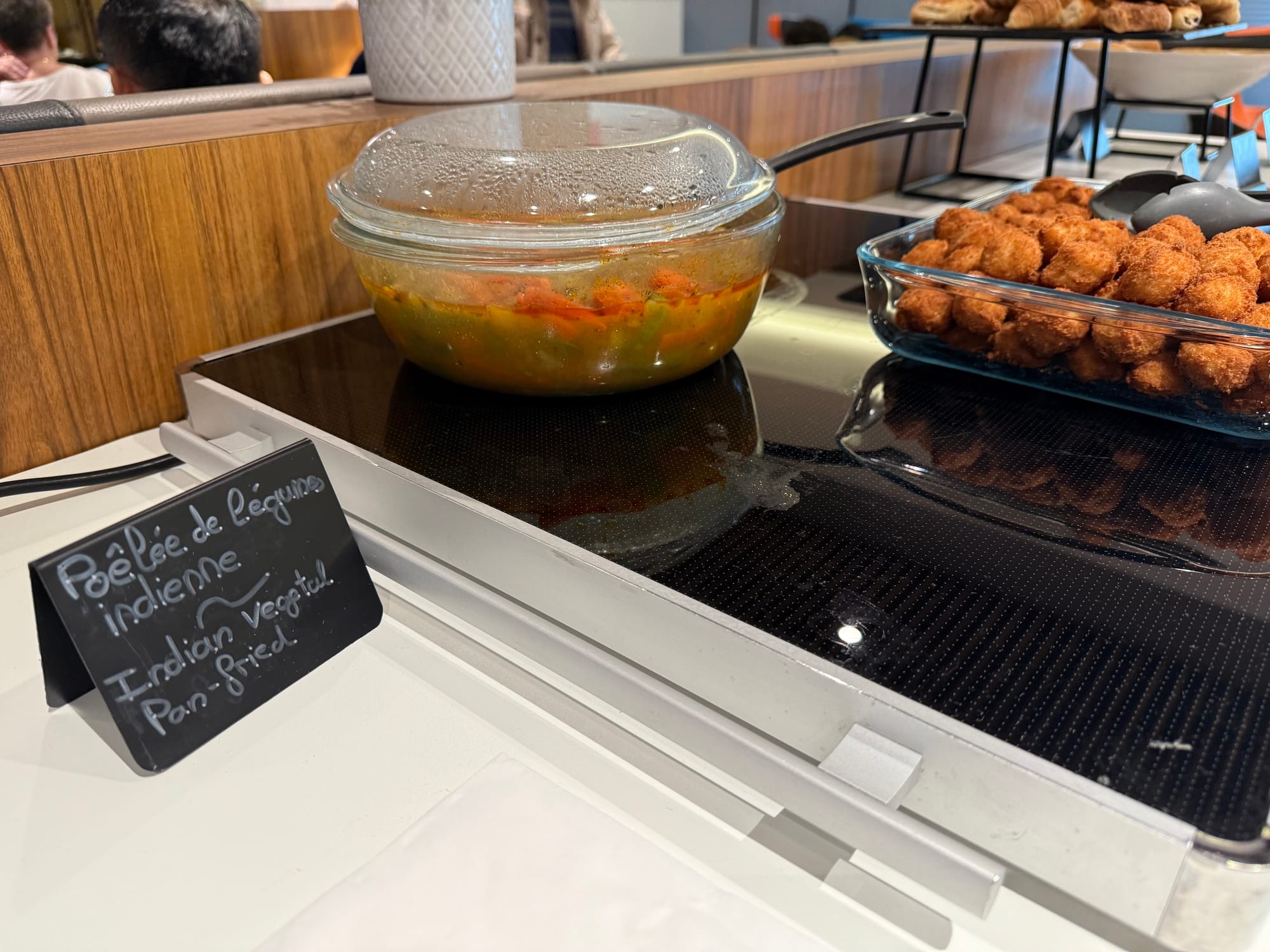
Boarding was a disorganised mass crowd affair, with Lufthansa’s ground handler Aviapartner as ineffective and couldn’t-care-less as usual, boarding passengers with no check of boarding group onto the jetway long before the crew were ready to let people onto the plane. Lufthansa is not the only airline to have issues with its ground handlers away from its main airports, but this was nonetheless a poor airport experience overall.
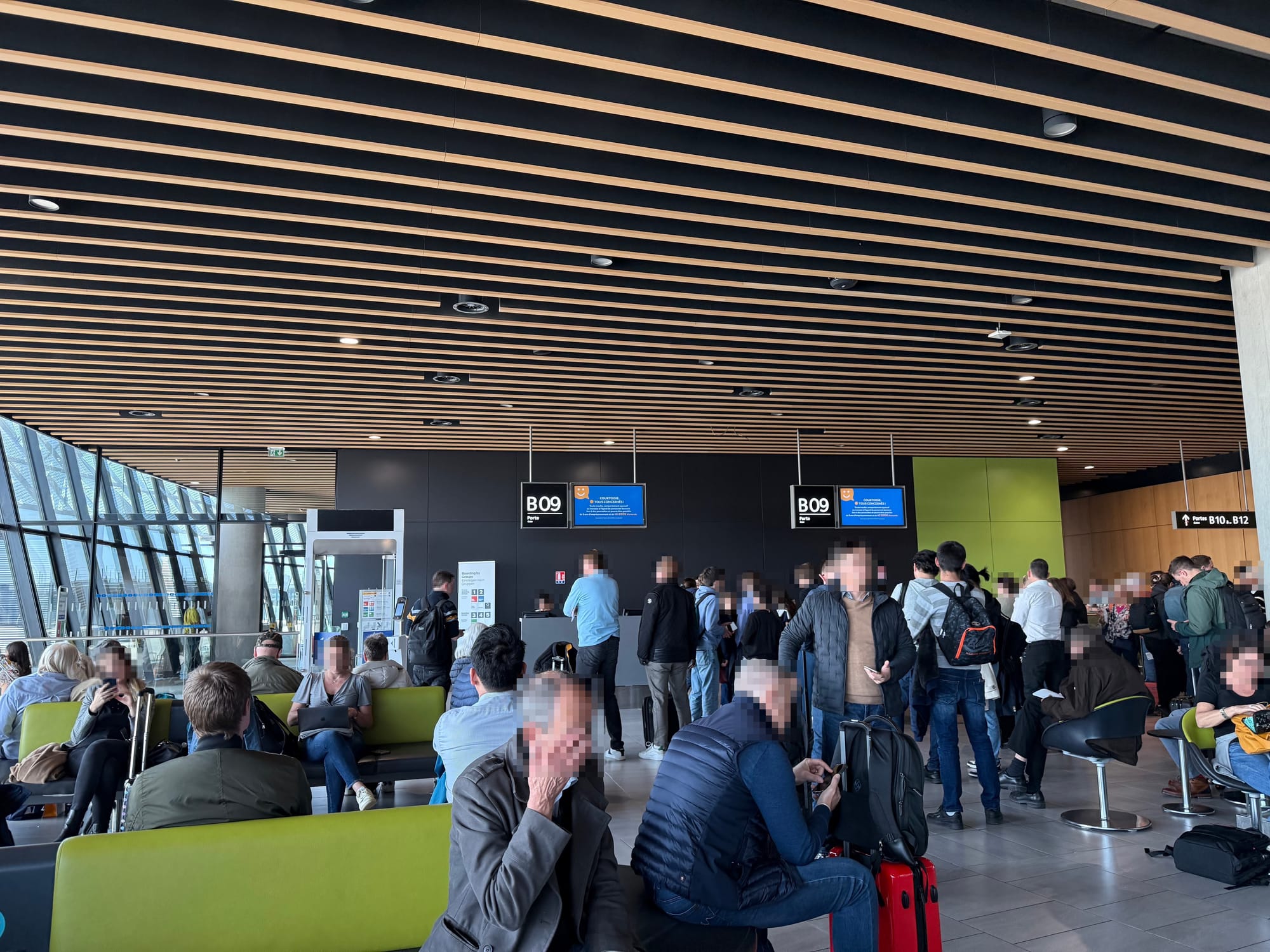
On the first connection, the flight was delayed into Frankfurt and arrived at a bus gate after a notification that my connection was at risk, which meant having to pelt through Europe’s worst hub airport at speed to make the onward flight. FRA is worse and worse every year: not only does its ugly industrial grey aesthetic get more miserable with time, but basic functionality like the moving walkways (necessary for its enormously long finger piers in Lufthansa’s terminal) were just broken — and remained broken on my return — with no visible work going on to fix them.
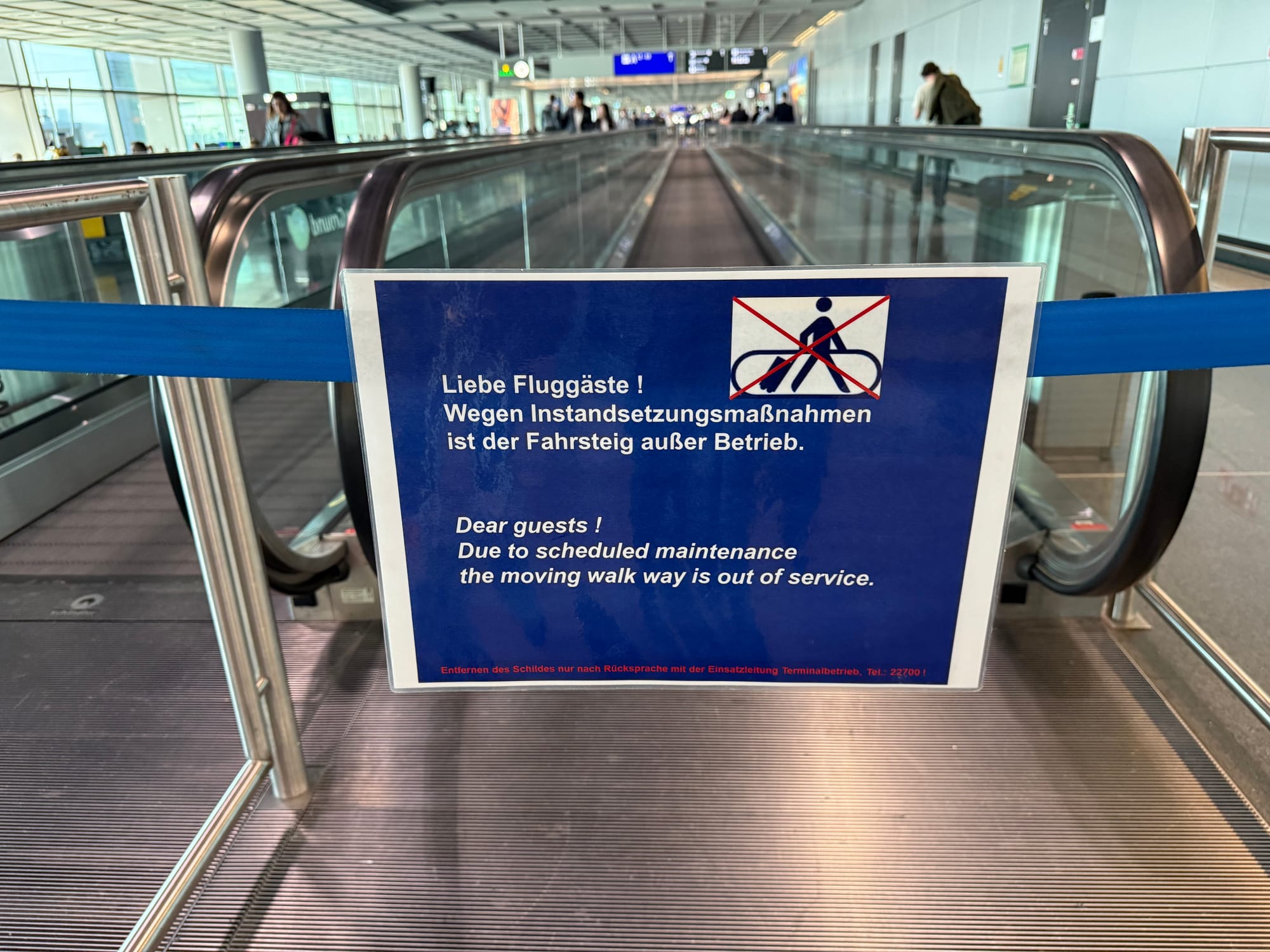
With such a short connection, there was no chance to visit any of Lufthansa’s Frankfurt lounges on this trip, but having experienced them before I wasn’t heartbroken.
I did, however, note that in Frankfurt Lufthansa has installed floor decal markings to try to separate out the various boarding groups in order to avoid a giant scrum. This didn’t really work on either of my departures from Frankfurt, perhaps because there was no announcement from the staff seated at the desks, let alone someone walking around to get people into the right queue, but it was at least nice to see that someone has given this some thought.

On arrival into Hamburg (and indeed on departure) it was remarkable yet again how poor the passenger experience is in the city where the European passenger experience industry is clustered. From the aging, grotty terminal to the depressingly slow baggage service (and indeed the coin-requiring baggage carts with broken coin exchange machines, and no token dispensers), this is not a pleasant experience.
On departure from Hamburg, Lufthansa had just one bag drop staffer for business class, which given the flow of passengers led to an unacceptably long wait at one of its major airports.
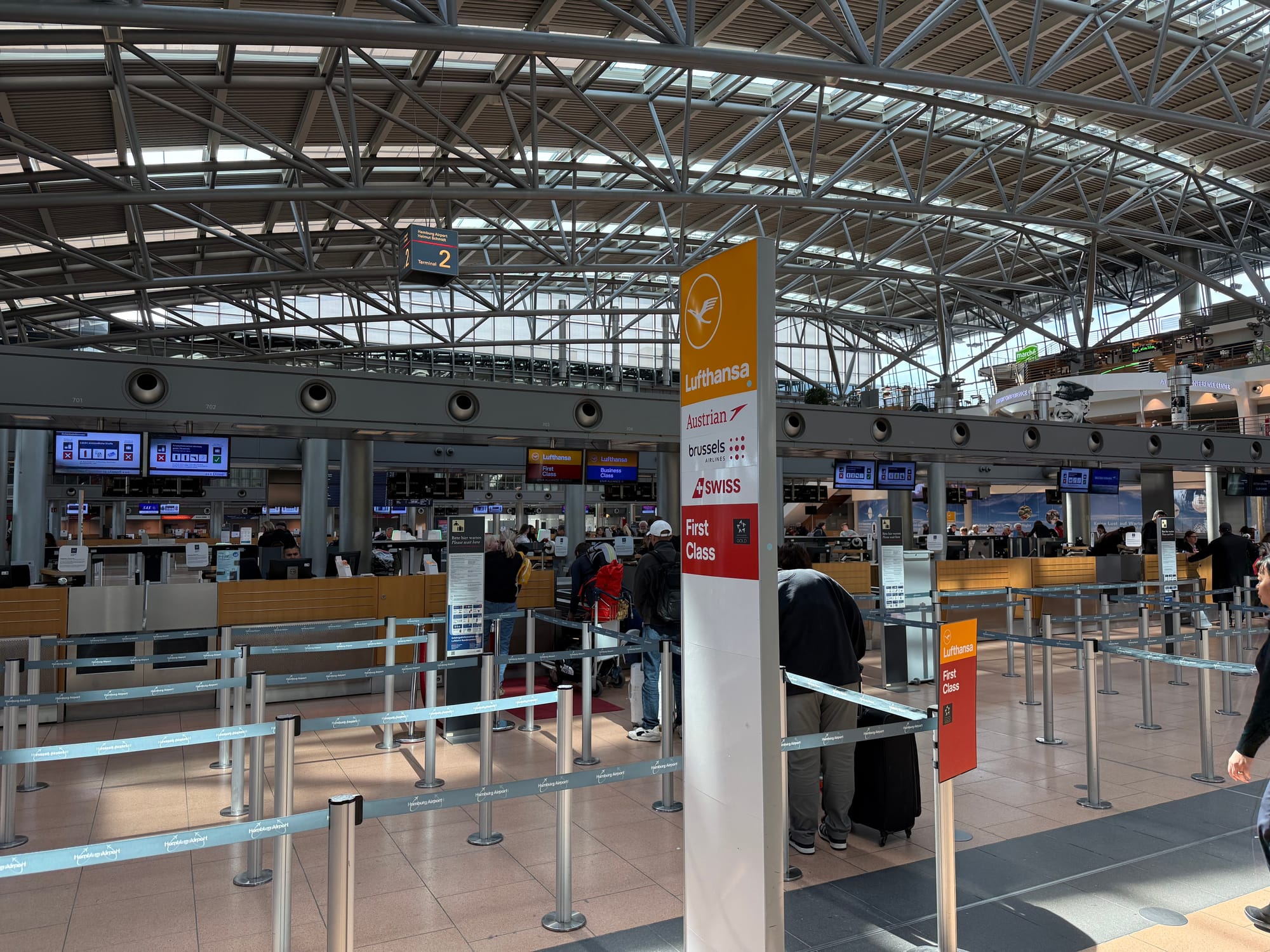
Lufthansa may not be able to fix the Hamburg Airport security line, but as the largest airline group it should have some influence. For example, the poor experience here is exemplified by the fast track security experience.
One would assume that this would be where you’d find business class passengers with two pieces of carry-on luggage, one of which would be a rolling bag here in the land of Rimowa, yet for some unfathomable reason the airport has three full steps up from the fast track area to the rest of departures — annoying, but also rendering the fast-track area simply inaccessible to a wheelchair user or someone with sufficiently reduced mobility.

Lufthansa’s Hamburg Business lounge remains the grim, soulless room it has been for more than a decade, but on this trip an added pleasure was limited lift access owing to construction.
In the lounge, seating was limited, power points scarce, but the wifi was at least fast, enabling me to pull down a few episodes to watch on the way.
The food, though, was truly dire, even after a week at AIX largely spent with convention centre catered options, although in fairness not as bad as Lyon. Yes, it’s an outstation, but Hamburg is an important outstation for Lufthansa.
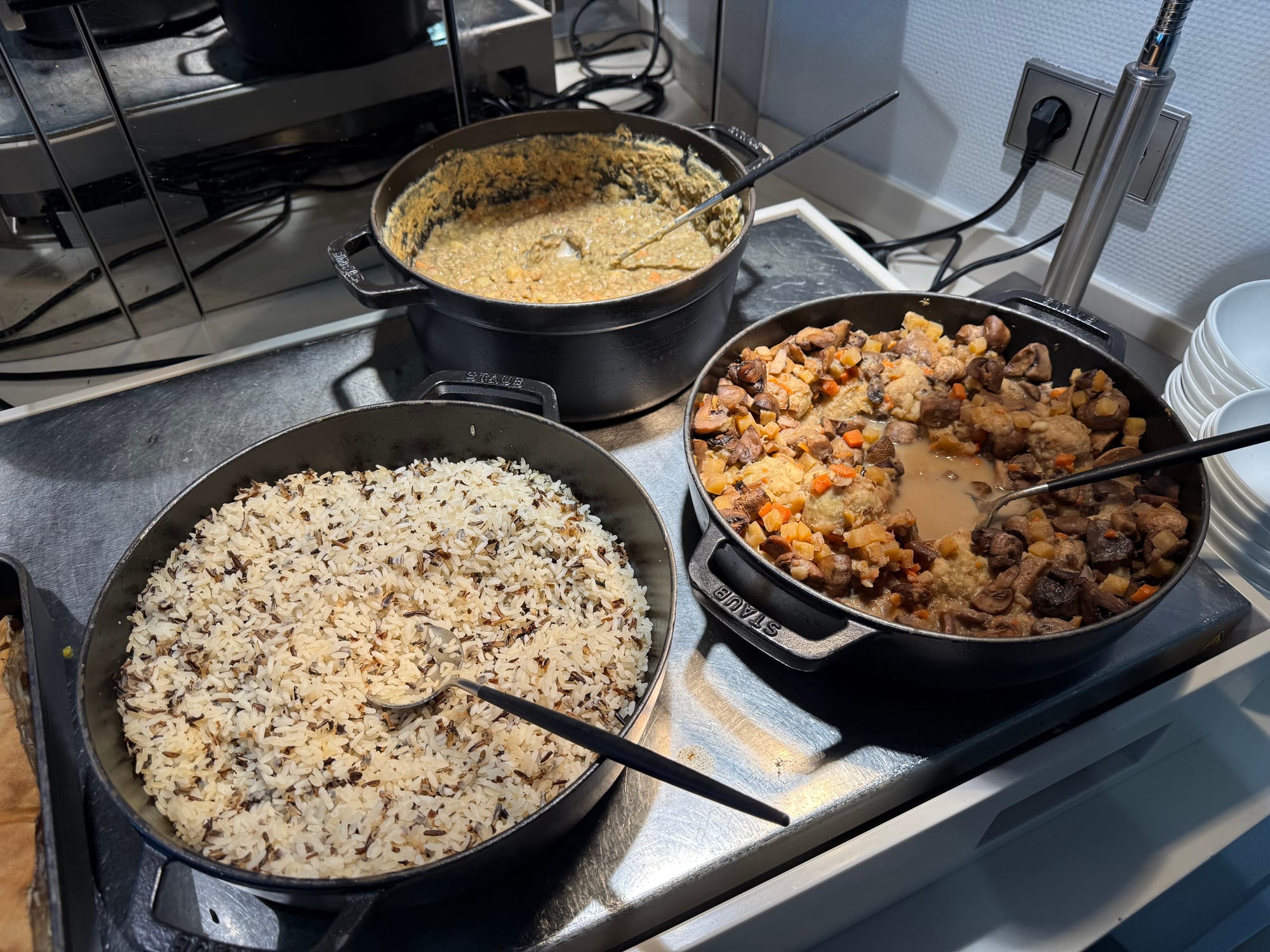
Boarding at Hamburg was also a total scrum, with passengers spilling out of a gate area far too small for the flight — to the point that it was impeding passenger flow through the airport — with no attempt by the gate agents or any airport staffers to do any organisation whatsoever.
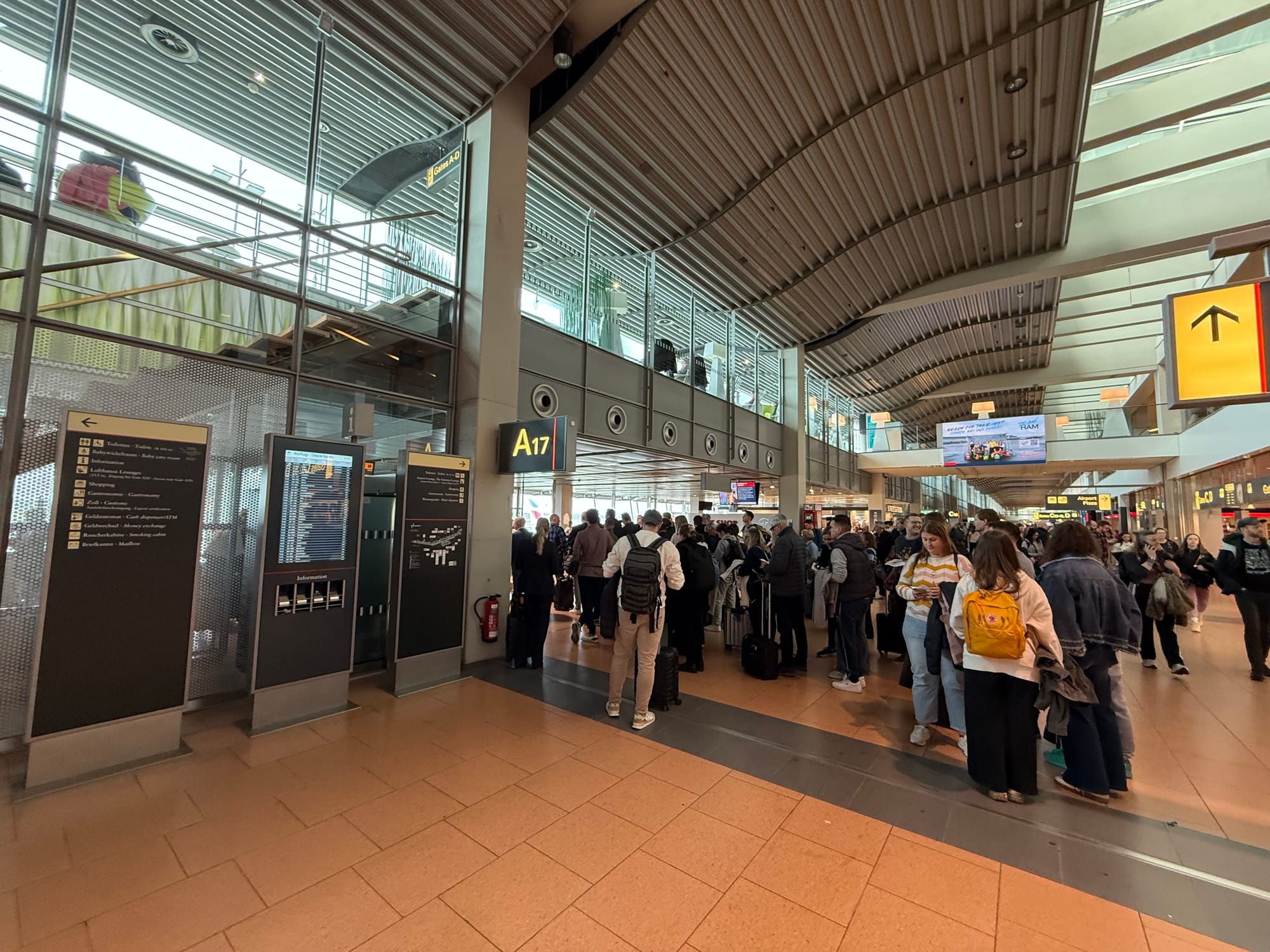
In Frankfurt on my return, I had 45 minutes or so to spend in the Business lounge, but it was so busy, crowded, stuffy and unimpressive that after a very quick bite to eat and a refill of my water bottle I decided to go sit at an unused gate for more comfort, space, peace and quiet instead.
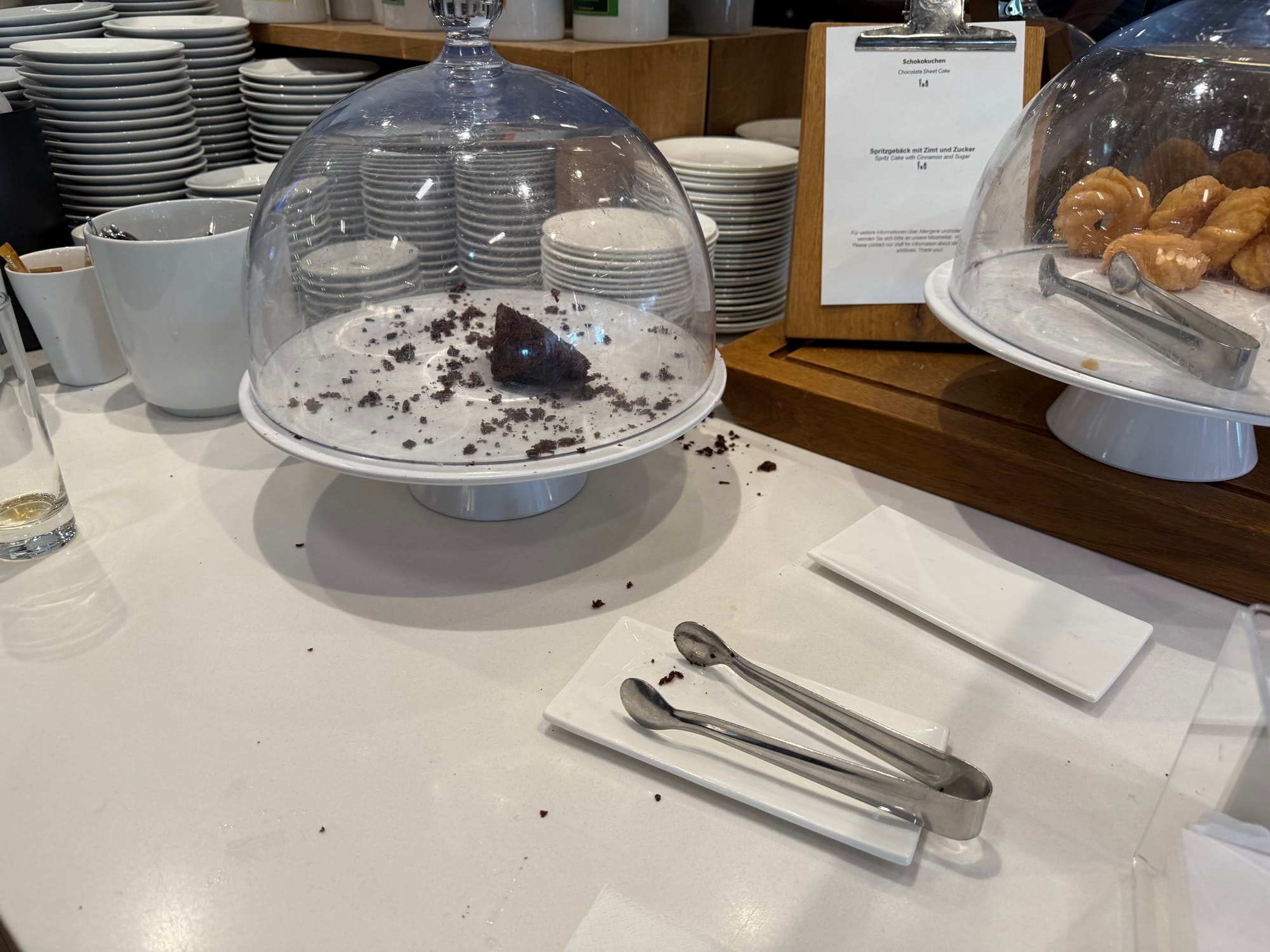
Neither of the Lufthansa lounges had adequate space to get some work done, nor were there adequate power sockets to recharge devices or keep them topped up. Wifi was good, though, with strong service via their longterm partner T Mobile.
Lufthansa needs to drastically revamp its lounge offering. A key part of the problem is that the model Lufthansa uses for its lounges is unique among airlines: business class passengers get a worse quality lounge than frequent flyers do in the Senator (Star Alliance Gold) lounge. Neither the Business nor Senator lounges are very good in comparison with others, mind — Air France and even British Airways eclipse them in almost every case at their home hubs and key outstations.
Cabin and seat: the dictionary definition of average Eurobusiness
Overall, the cabin and inflight experience were incredibly consistent, despite one of the flights using the newer Geven Essenza seat and the rest the older Recaro NEK. The overall aesthetic remains the standard Lufthansa dark greys with navy blue accents, reminiscent of nothing so much as the grim soulless office-by-the-hour experience before WeWork made the soulless office-by-the-hour experience at least a little more visibly pleasant.
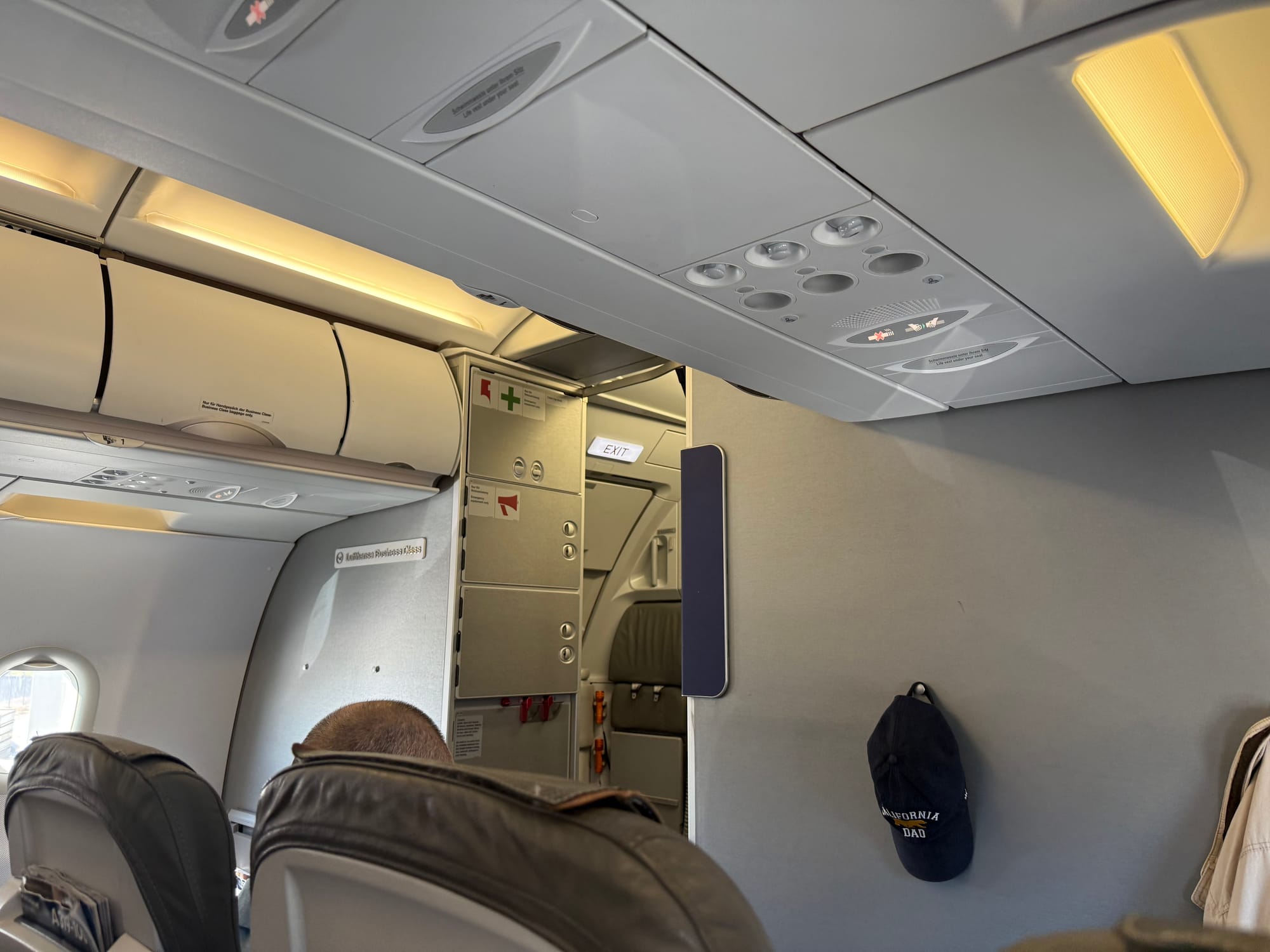
Of the four flights on this trip, my aircraft were:
- a 12-year-old A319 with the NEK Recaro BL3520 seat
- a 15-year-old A320 with the NEK Recaro BL3520 seat
- a 5-year-old A321neo with the Geven Essenza seat but without the Airbus Airspace cabin
- a 12-year-old A319 with the NEK Recaro BL3520 seat
Throughout, the NEK Recaro BL3520s looked very hard-used — which is actually much better in terms of seat comfort than a brand new set, since the structures and covers of the seat have time to be broken in to the form of the human body, as seen by the notably visible buttocks imprint on my right-hand window seat’s pan.
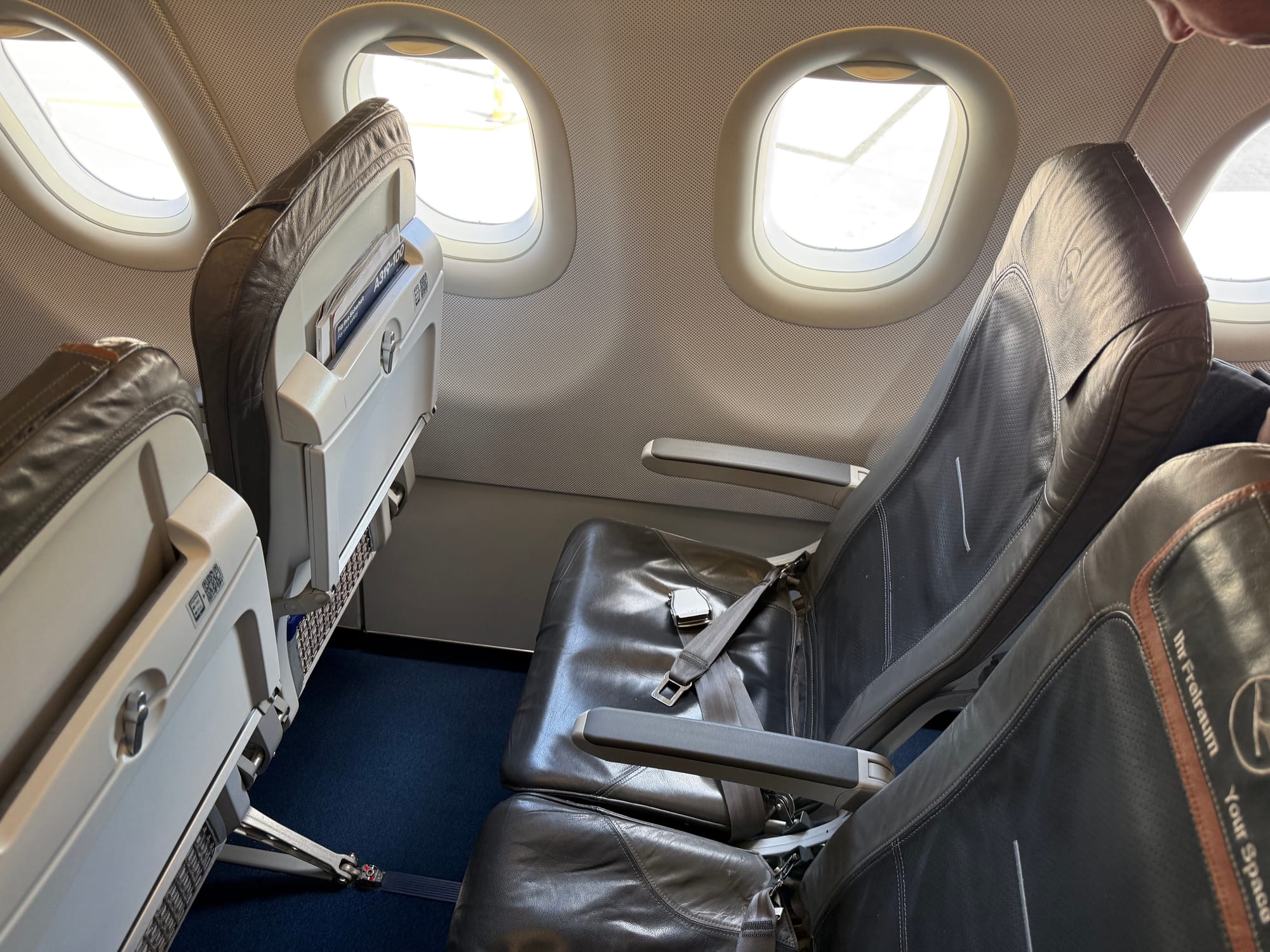
In terms of comfort, the Geven Essenza is to my mind a better seat, with better body support and more knee and shin room thanks to the series of structural innovations in the late 2010s where horizontal seat row supports were moved forwards and out of the way of the knees of the passenger behind. Of course, the neos with these seats make up only a part of of Lufthansa’s fleet, and with the airline operating so many elderly aircraft — it has A321s that are literally thirty years old — there’s no way to ensure you get Essenza rather than NEK.
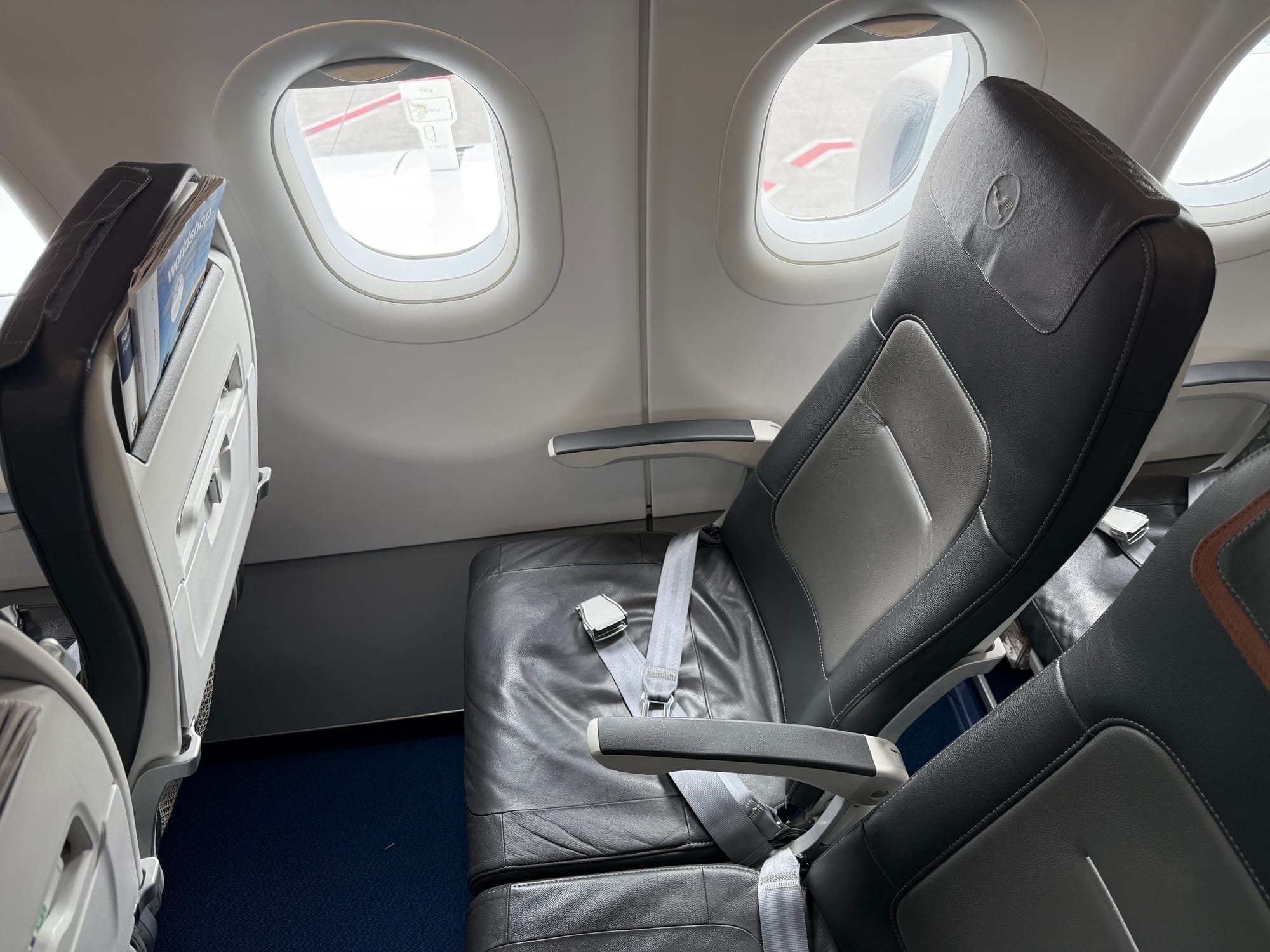
Compared with other airline options, though, both NEK and Essenza felt substantially more spacious and comfortable than the British Airways Pinnacles that make up most of Club Europe, and far better than the older seats BA is still flying on some aircraft. It feels like they’re a bit more spacious than the standard Air France product, and much more so than KLM’s elderly 737 cabins (though I have yet to make it on a KLM A321neo). And, of course, they’re exactly the same as found on the other Lufthansa Group airlines.
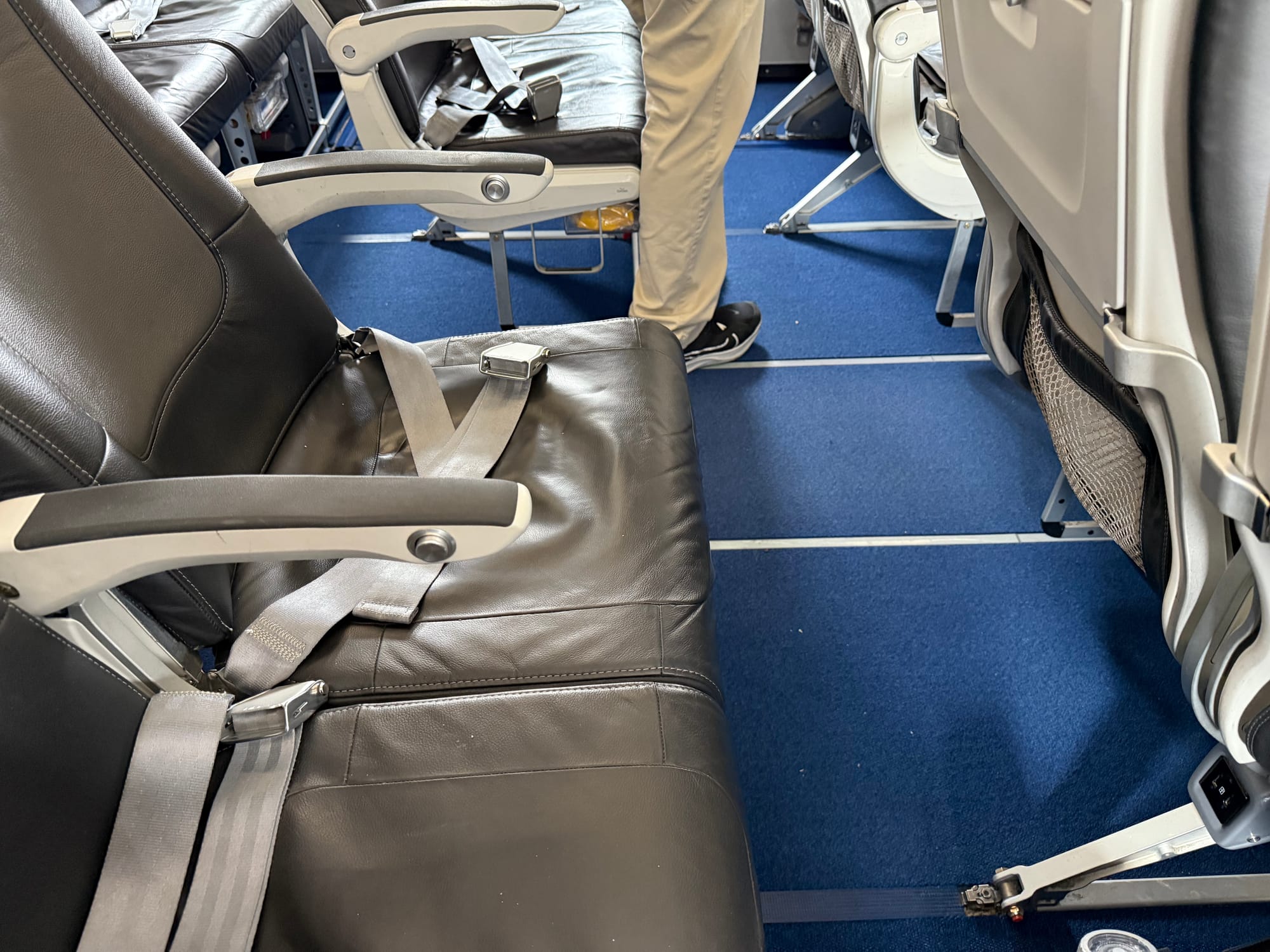
Only flight three on the A321neo had at-seat power, via a pair of USB-A/C sockets per row. I really missed these on the other flights, especially with the lack of inflight entertainment and the amount one uses one’s phone for connection information. Given how long Lufthansa flies its older cabins, this is again room for improvement.
Of note, though, the cabin cleanliness needs much work. The seats on my first and second flight could have used a very good wipedown with a damp cloth (or even perhaps some cleaning fluid), since they were quite heavily stained with various drips and drops. The seat space on flight three, meanwhile, was very crumby, and I noticed several other passengers also having to brush off their seats. The fourth flight was less so, but there is room for much improvement here.
Inflight service, food, beverages and service: not bad at all, but I hope you like asparagus
My expectations for a shorthaul business experience with Lufthansa are around efficiency rather than luxury, and all these crews delivered on those expectations.
During boarding on my first flight, I noticed how the crew were continually announcing how full the flight was and how passengers needed to stow bags under their seats, in German, English and French. This was a little strident, and didn’t exactly contribute to a warm and welcoming atmosphere. It didn’t happen on other flights, and it struck me that given how ineffective and low-effort their ground handler in Lyon is, this may be a local situation where larger bags are not diverted into the hold via gate agent initiative. That said, other airlines are now using prerecorded announcements with calming boarding music and a more pleasant-yet-firm tone, so this is definitely some room for improvement.
Lufthansa’s meal concept on flights like these (on both trips, the first flight departed at roughly 1400, with the second flight at about 1700) is a tray with a chilled main plate with a warmed bread roll and a small dessert. It’s not what most people would call “a full meal” as Lufthansa promises in its marketing: “light meal” or “starter and dessert”, perhaps, and included:
- an asparagus salad with feta, olives, walnut and passion fruit, then tiramisu
- vitello tonnato (veal slices with tuna sauce) and artichoke hearts, then a chocolate entremet
- that same asparagus salad again, but with a sachertorte-inspired mousse cake
- prosciutto-style ham with parmesan shavings and a spelt salad, with the same tiramisu as the first menu

On balance, it’s probably right: these are tasty enough, have wide enough appeal are reasonably healthy if not hearty, although the crew always did a second bread round that would have helped for anyone hungry. I imagine anyone particularly ravenous could always ask for a second plate, not least since some passengers didn’t take the crew up on the dining offer.
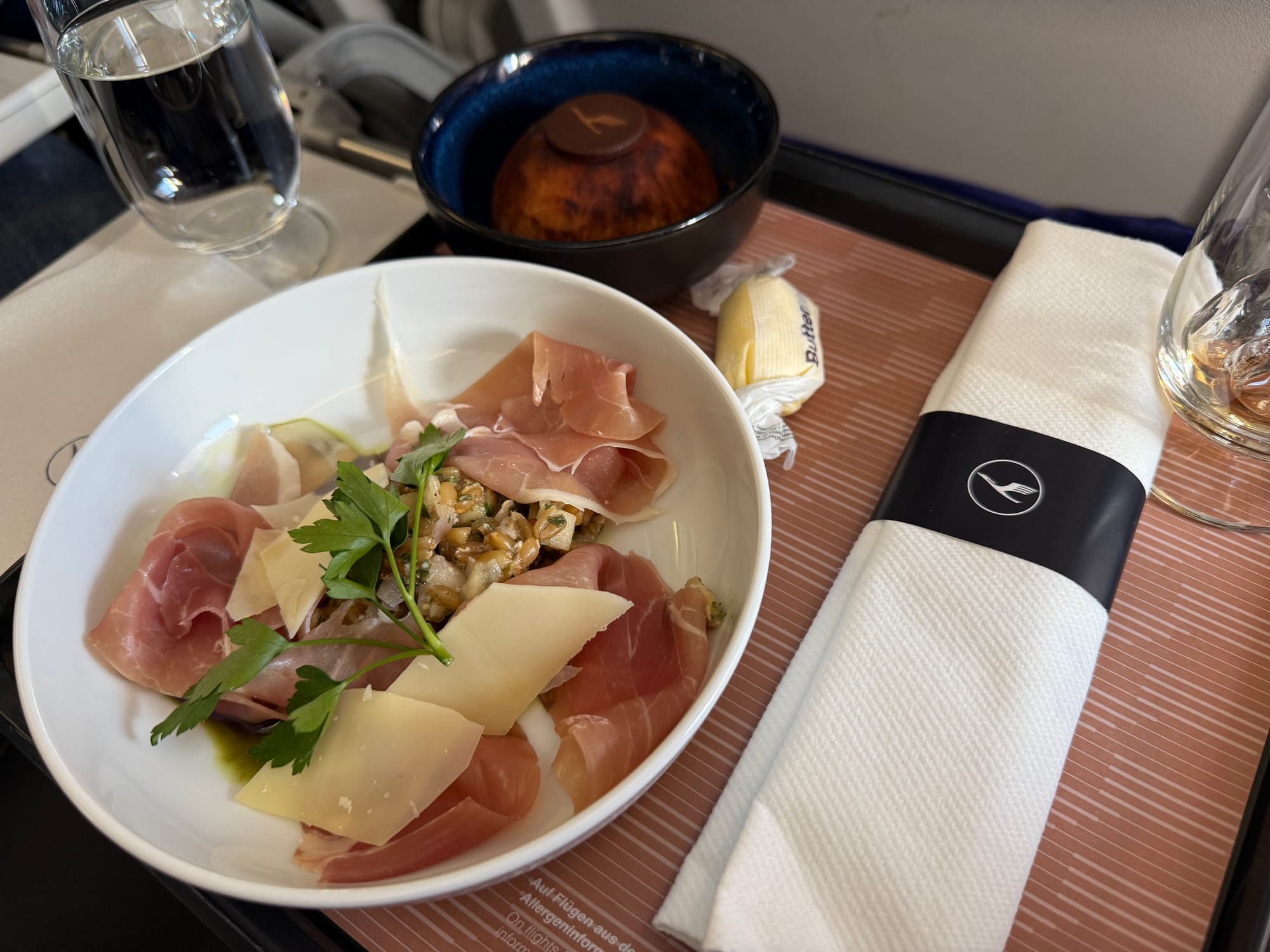
This concept remains largely unchanged for a decade, with the biggest evolutions being a small menu pamphlet, Lufthansa-branded butter twist, the dessert being presented in a blue bowl, and the addition of the Lufthansa Ziegler Avionic cocktail. That these are the biggest evolutions are, indeed, a sign that Lufthansa thinks it has a handle on what its customers want and need.
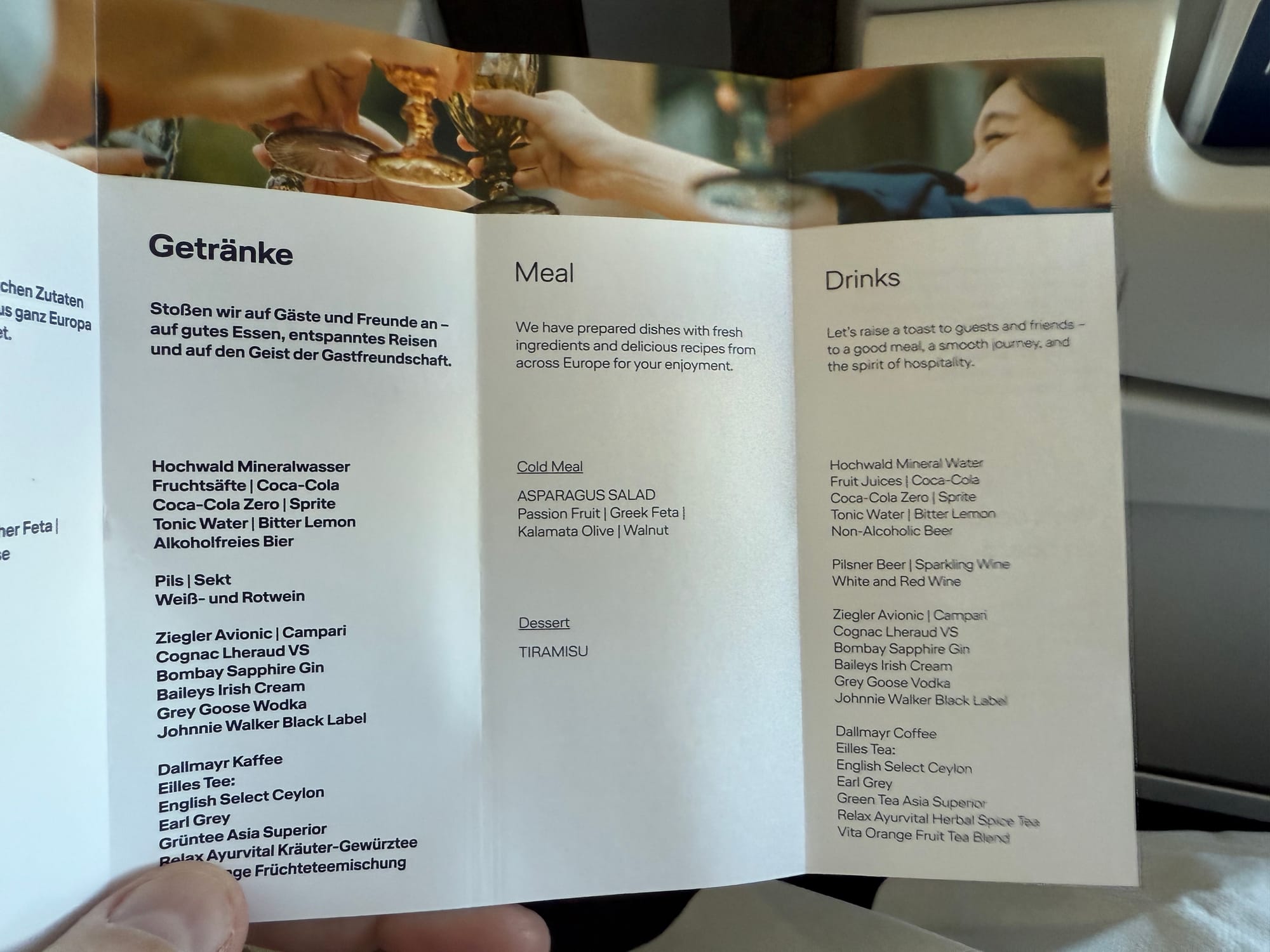
In European shorthaul context, it compares favourably with Air France’s mini-snack box, KLM’s plastic Delft-style boxed salad and British Airways’ plated dishes. It might be smart to vary the meals a little more based on route, given the repeat of the asparagus salad, but in fairness one can’t really fly on a German airline in April at the start of the Spargelzeit asparagus season and be surprised to be eating asparagus.

Lufthansa’s drinks menu is fine if not remarkable. Having a non-Champagne sparkling wine is a bit of a disappointment (not least since stablemate Brussels Airlines does), but the sekt is at least German and usually drinkable, whatever label it ends up being — especially as a bubbly cocktail.
On which note, it’s a plus from me for their branded Avionic cocktail, a tasty bitter aperitif similar to Campari or Aperol of the sort popular in many European countries, and indeed especially in Germany — you may have seen the viral Aperol Spritz song from last year. It’s especially tasty over the German sekt sparkling wine they serve, but better in about a 40/60 or 50/50 bitter to bubbly mix than the 80/20 that the crew use when they pour a full measure of the Avionic over ice in the tiny glasses.
The meal finishes with a chocolate praline handed out from a tray-box of individually boxed pralines: these are delicious and a lovely premium touch.
The inflight service was efficient if perfunctory, with a tea and coffee run after the meal, followed by the crew returning to the front galley and closing the cur but on these short flights that’s no bad thing.
Entertainment and inflight connectivity: average, with room for improvement
Like all European shorthaul, there’s no seatback inflight entertainment on board, although all four flights had working wifi with Internet connections. Inflight connectivity was via Lufthansa’s FlyNet, advertised by the QR code on the seatback that takes you right to the login screen.
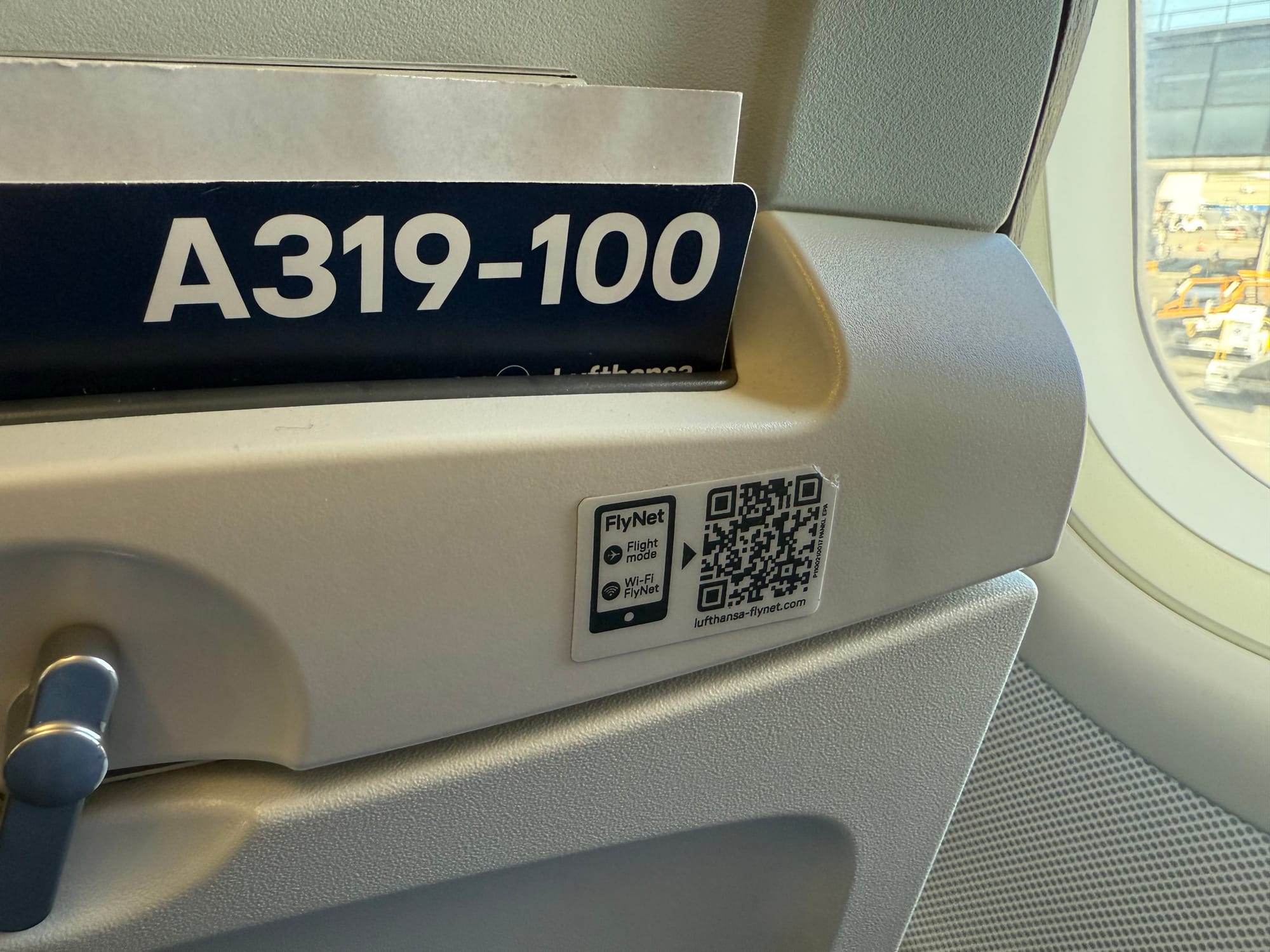
With four short flights of either just under or just over an hour gate-to-gate, I only used the free messaging service and the included app connectivity — 6€ per flight seemed steep for less than an hour from pushback to “you may now use your phones” after landing. It was good to be able to send a few messages, though, and to figure out where my connecting gate was.
![Screenshot, Lufthansa app. It shows a free messaging option "Provided by [T-Mobile logo]" for up to 150 Kbit/s, or a Premium option for 6 EUR or 2,000 miles for up to 4 Mbit/s.](https://theupfront.media/content/images/2025/05/IMG_7297-9642bfbbfcd3df6f.PNG)
Instead, I relaxed with some YouTube and Dropout videos I’d downloaded to my phone before heading to the airport. Neither the Recaro NEK nor the Geven Essenza seat offered any kind of phone or tablet holder, which feels like something to consider for the next generation of seat. Given the lack of IFE across European airlines I’ve started travelling with a clip-on phone holder that will secure to almost any eye-level seatback pocket or even the top of the tray table, which worked fine.
Overall conclusions: a fundamentally average Eurobusiness product across the board, except for the truly sub-par airport experiences
Lufthansa promised relaxation, comfort, space to work and a full meal. The onboard experience was relaxing enough, but at all four airports it was anything but. Onboard, I don’t think that a Eurobusiness seat is particularly comfortable, and the lounges certainly weren’t. Space to work? Not at the lounges, and onboard it would have been a challenge to pull out a laptop, while the absence of power sockets on three out of the four flights (and indeed at the lounges) meant battery anxiety. While the meals were tasty, you couldn’t honestly call them “full meals”.
Lufthansa is really let down by its airport processes and lounges: these are below par, and that drags the overall experience down quite a bit given that passengers might spend more time in the airport and lounge than in the actual air, especially with a longer connection.
But compared with other Eurobusiness classes, the onboard experience was… fine. Reliably fine. Consistently okay. Lufthansa knows what it wants to deliver, and delivers a workaday, unexciting product: the average Eurobusiness experience against which all others are measured.
Continue reading more on business class and premium classes at The Up Front with:
- our deep-dive analysis of the studio-class suite product generation
- a competing product from Safran Seats, the Visa, as Air New Zealand’s new 787-9 Business Premier and Business Premier Luxe
- more about us as we launch The Up Front — our people, principles and technology for bringing you a new type of independent aviation journalism
- why we created The Up Front, why we write, and how you can support our new model for aviation journalism


